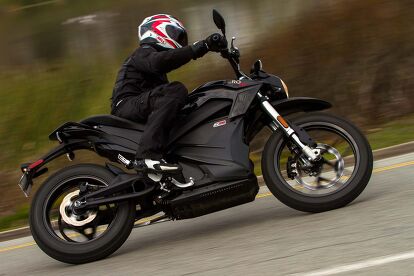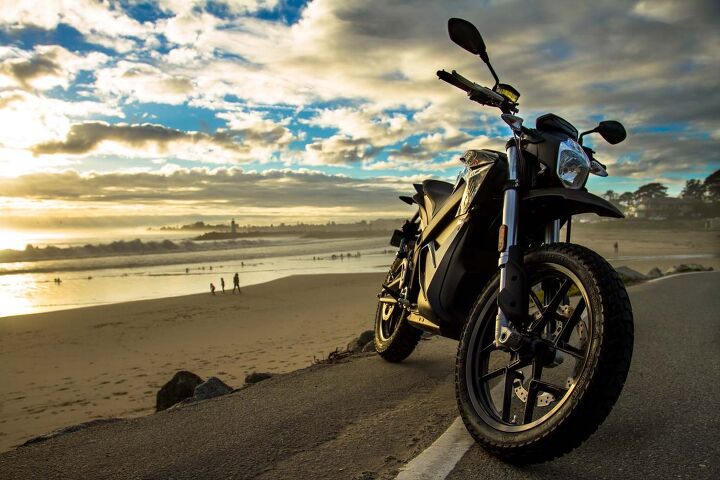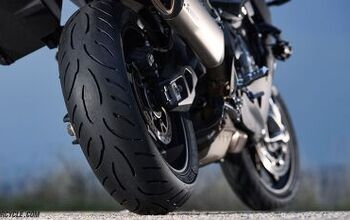2016 Zero DSR First Ride Review

Zero's dual-sport gets energized
I still remember how wide my eyes were the first time I twisted the e-throttle on Zero’s new-for-2014 SR. Any word associations I had prior to “electrics” and “slow” were well and truly shattered. With a claimed 106 lb-ft of torque – more than a Suzuki Hayabusa – available at an instant from its high-output motor and 660-amp motor controller, and no clutch or gears to finesse, there are few things that can beat it in a stoplight-to-stoplight dash.
2016 Zero DSR
| Engine | 19.0/20 |
| Suspension/Handling | 12.0/15 |
| Transmission/Clutch | 10.0/10 |
| Brakes | 8.0/10 |
| Instruments/Controls | 5.0/5 |
| Ergonomics/Comfort | 9.0/10 |
| Appearance/Quality | 7.0/10 |
| Desirability | 7.0/10 |
| Value | 6.5/10 |
| Overall Score | 83.5/100 |
The question I had after riding the SR in its First Ride Review, and after living with one, was when would we see the hot-rod motor and controller in the DS, Zero’s co-flagship dual-sport offering? The DS shares the same basic frame and platform with the S and SR models, so transplanting the motor controller is a plug-and-play affair.
The answer is now, and the model name, in case you couldn’t guess, is the Zero DSR. It was only a matter of time before the DS received the same hi-po internals as the SR, and the benefits as well. That translates to 25% more power than the standard DS (67 vs. 54 hp) and 56% more torque (106 vs. 68 lb-ft). The DSR also benefits from the same high-temp magnets from the SR, now housed in an all-new motor, discussed below.
A Breakthrough In Motor Design
Apart from the two new models introduced this year, Zero’s big news is its patent-pending Interior Permanent Magnet (IPM) motor, which is set to gradually phase out the current Surface Mount Permanent Magnet (SMPM) motor in use since 2013. For a clearer explanation between new and old, I turned to Zero’s Chief Technical Officer, Abe Askenazi. Without getting overly technical, Askenazi notes one of the main design flaws of the SMPM motor is its design places the magnets on top of the rotor, requiring complex and costly gluing and banding, making it tricky to manufacture. And though it met the power requirements Zero was looking for, hard street riding could cause it to overheat and trigger thermal cutback, which we’ve experienced in our own testing, most notably on the racetrack.
IPM motors bury the magnets within the rotor, which makes for less complex (read: cheaper) manufacturing, while also moving the magnets away from the stator, thus reducing the amount of heat produced. The downside, says Askenazi, is that moving the magnets away from the coils in the stator usually results in less power. For the past two years, Zero’s Director of Powertrains, Ryan Biffard, made it his task to design an IPM motor that could produce the same amount of power as the SMPM motor while still delivering the benefits of an IPM.
For the 2016 model year, Biffard succeeded in doing so, producing an IPM motor that equals the power from the previous SMPM (but does not produce any more power than before). It produces less overall heat compared to the SMPM, and the metal rotor the magnets live inside acts as a heatsink to absorb the remaining heat still produced. Plus, the rotor is a petal shape instead of being perfectly round, providing a slight cooling effect as it spins.
Ultimately, says Askenazi, this new motor “gained 45º Celsius [113º Fahrenheit] of thermal capability, which now takes it into a motor that doesn’t run into its thermal limitations on the street.” If you’re interested in a more in-depth explanation of the new motor, Biffard himself explains the Z-Force IPM design in this video which you can also watch above. Ultimately, the new motor enables the rider to ride harder for longer, and if thermal cutback does set in, its effects will be less noticeable. The IPM motor will be available as standard equipment on the following models: Zero DSR, Zero SR, Zero FXS, Zero S ZF13.0 and Zero DS ZF13.0. The SMPM motor remains in the Zero S ZF9.8, Zero DS ZF9.8, and Zero FX.
Improved Battery Tech
Zero likes to tout its Power Packs as having the highest energy and power density in the EV market (yes, even compared to a Tesla), necessitated by the fact motorcycles have inherent packaging restrictions, meaning they need the most power in the smallest space. Now, constant development by Zero engineers means that Power Packs across the Zero range have even more density than last year. Askenazi says this was achieved via a modified ratio of metal oxides in the cathode and an added graphene matrix in the anode, yielding anywhere from 10%-20% more range from last year, depending on the model.
The DSR utilizes Zero’s highest-capacity “four-brick” ZF13.0 (11.4 kWh nominal) Power Pack. “Brick,” for those not in the know, is the colloquial term for the amount of cellboxes inside of a single Power Pack. Each brick contains 28 cells in series, interconnected, fused and instrumented in a waterproof box.
Add on Zero’s range-extending $2,674 Power Tank option – a 2.8 kWh cell, or an additional brick installed in the faux fuel tank storage compartment – and Zero claims up to 179 miles of all-city riding and a combined city/highway range of approximately 116 miles. Without the Power Tank, Zero claims a respectable 95 combined miles assuming highway speeds don’t exceed 70 mph.
Despite the advances Zero has made in battery and motor technology, the achilles heel for electrics remains range and charge time. Ever-improving battery chemistry helps with the former, while the latter still remains an issue. However, with the growing popularity of level 2 charging stations, Zero’s new dealer-installed accessory for 2016 is the $1,988 Charge Tank, a high-speed charger that accepts J1772 plugs found at most level 2 stations and complements the 1.3kW on-board charger to produce 3.8kW, reducing charge times to as little as two hours.
Partnerships with Showa, J.Juan, Bosch and Pirelli first seen on 2015 models carry through to 2016, the DS receiving a fully adjustable 41mm inverted Showa fork and similarly adjustable Showa shock. Suspension travel is 7.0 inches front, 7.3 inches rear, to better cope with the light off-roading the DS was intended for. Pirelli MT-60 tires wrap the 19-inch front and 17-inch rear cast wheels – a sign the DS isn’t meant to be a hardcore off-roader. A 320mm disc in front is mated to a J.Juan twin-piston caliper and steel-braided line, while a single-piston J.Juan caliper clamps against a 240mm disc in the rear. Bosch ABS keeps the wheels from locking under hard braking, but can be switched off either via button presses on the dash or simply doing a burnout.
The Ride
To put the new DSR through its paces, Zero invited journalists to its Scotts Valley, California, headquarters to go on a spirited ride through the local twisties on the way to the famous Alice’s Restaurant, roughly 45 miles away. Along the way, making a turn off pavement to give a taste of the DSR’s mild dual-sport chops was also in the cards.
Having ridden the SR model previously, hopping on the DSR isn’t entirely different. A slightly taller seat height (33.2 in. vs. 31.8 in.) is the most noticeable difference. Seating position is fairly neutral, with a relaxed knee bend and the new-for-2016 handlebar being slightly taller than before for a more upright ride. The seat itself is still a little hard for my taste, but that thought quickly fades away with a twist of the throttle. Torque is the name of the game with electrics, and with 106 lb-ft. waiting to be freed, the DSR gallups away in the blink of an eye. The only noise heard is the whine of the motor and the friction from the belt drive. That said, the calibration of the e-throttle is very progressive and user friendly – Zero engineers knew not to give 100% power at the slightest degree of throttle turn.
On pavement, the 19-inch front hoop results in a motorcycle that’s less eager to flick into turns than its SR cousin, but a good shove on the bars will point the bike where you want it. Pirelli’s MT-60 is far from a sport tire in its edge grip, however, with overnight rains the day before our ride making the roads slick and littering them with dirt and debris, the DSR was still able to blast a quick pace, the knobby MT tires providing a bit of confidence in the crummy conditions.
Some editors on the ride found the ABS intervened too soon for their taste, though I was not one in that camp, especially considering the wet roads. I will say, though, that hard braking over bumpy pavement is enough to confuse the system into activating – a situation I learned to remedy by applying the brakes earlier and with less force. Other than that, the single 320mm petal disc, twin-piston caliper and steel-braided line provided impressive stopping power and feel. Even the rear brake, which was an on/off switch in the past, now has a reasonable amount of feel at the lever.
Though the DSR might technically be a dual-sport, with its cast wheels and a claimed 419 lbs., it isn’t fooling anyone. If one really wants to ride off the beaten path on an electric, they’re better off grabbing an FX instead. That said, the DSR thrives if the goal is to explore fire roads. Without gears or a clutch to worry about, off-road novices like Yours Truly are able to focus on the other aspects of dirt riding – like managing all that torque in such slippery conditions.
Our off-road time was extremely limited during this ride, so a proper evaluation will have to wait until we get one in our hands. With that much weight to carry though, I don’t know if I’d want to navigate a single track with it. Lastly, were it mine, I’d want to raise the bars even more to ease navigation while standing.
The Big Question
So far, the performance of the DSR has been about what I expected. The monstrous acceleration wasn’t a surprise after experiencing the SR, and I was quite happy with the DSR’s ability to live up to the S in its name through the twisty (and wet) asphalt. What you, the readers, always ask is how far it can go on a charge.
This is a tough one to answer since range is heavily dependent on riding style. This time, though, I purposely kept the bike in Sport mode and didn’t hold back, riding like I would any other motorcycle. The trip to Alice’s Restaurant, our mid-way point, was about 45-miles. Though there were no freeway miles, the pace was rather spirited, with top speeds approaching 70 mph at times. By the time we arrived, batteries were showing roughly 40% charge remaining. As a precaution, Zero decided to charge the batteries while we ate lunch and bombed around on Zero’s other new-for-2016 model, the FXS (which you can read about in a separate story), though I think we could have made it back to base without the plug-in.
As for the IPM motor, it never overheated or showed any hints of getting there, but the weather was chilly, we took frequent breaks, and any splash from the wet roads surely helped cool the motor. Basically, from the motor’s perspective anyway, the conditions were ideal for a day of hard riding. Again, a definitive opinion will have to come after we get one for testing, but initial impressions are positive.
So where does that leave us? Well, we’ve established the DSR is capable of freakishly quick acceleration, and can cut a decent pace on curvy pavement or non-technical dirt roads. At $14,395 after a $1,600 federal tax credit, the Zero DSR is still a pricey machine for a niche market. I hesitate to call the DSR a true dual-sport machine, especially in the face of the FX. Personally, with the longer travel suspension and taller bars compared to the S model, the DSR seems well suited to everyday commuter duty. Were it mine, that’s likely what I’d use it for. That and the occasional dirt road excursion.
Zero DSR
+ Highs
- Torque!
- Comfortable rider triangle
- Can hold a decent pace on pavement
– Sighs
- Off-road abilities are limited
- Seat’s kinda hard
- Range, charge time and price are close but not quite there

Troy's been riding motorcycles and writing about them since 2006, getting his start at Rider Magazine. From there, he moved to Sport Rider Magazine before finally landing at Motorcycle.com in 2011. A lifelong gearhead who didn't fully immerse himself in motorcycles until his teenage years, Troy's interests have always been in technology, performance, and going fast. Naturally, racing was the perfect avenue to combine all three. Troy has been racing nearly as long as he's been riding and has competed at the AMA national level. He's also won multiple club races throughout the country, culminating in a Utah Sport Bike Association championship in 2011. He has been invited as a guest instructor for the Yamaha Champions Riding School, and when he's not out riding, he's either wrenching on bikes or watching MotoGP.
More by Troy Siahaan





































































































Comments
Join the conversation
Ironically I need greater range on a bike than in my car, which is electric.
The electric bikes are getting awfully close though. Another 20% bump in range coupled with a 6.6+ kW J1772 charger or maybe a DC quick charge option and it's there for me. I suppose I'll hold on to my old CBR until that day arrives.
I like the tech. Things are improving for sure. I just can't imagine waiting for my bike to charge. I'd have to be constantly calculating if I could make it back home. "Sorry honey, bike is out of juice, looking for somewhere to charge it." or, "come pick me up in the truck, no place to charge!"
I dunno. Too many things that contribute to time NOT being spent actually riding the bike. Your just getting the hang of it and then you have to recharge. Ugh. I'd have to give it a thumbs down. In the northeast US where I live, we get a small window of good seasonal weather. This bike would take away more precious ride time and isn't that what it's about? Getting out there and riding?
This is where a KLR 650 looks great. Get on it and ride. Anywhere. Anyplace. Plenty of fuel. Dealing with my iPhone being charged is enough for me.